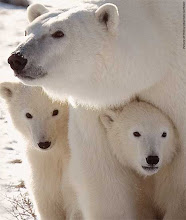By DAN JOLING
The Associated Press
Published: May 22nd, 2008 01:26 AM
Last Modified: May 22nd, 2008 10:10 AM
The State of Alaska will sue to challenge the recent listing of polar bears as a threatened species, Gov. Sarah Palin said Wednesday.
She and other Alaska elected officials fear a listing will cripple oil and gas development in prime polar bear habitat off the state's northern and northwestern coasts.
Palin argued there is not enough evidence to support a listing. Polar bears are well-managed and their population has dramatically increased over 30 years as a result of conservation, she said.
Climate models that predict continued loss of sea ice, the main habitat of polar bears, during summers are unreliable, Palin said.
The announcement drew a strong response from the primary author of the listing petition.
"She's either grossly misinformed or intentionally misleading, and both are unbecoming," said Kassie Siegel of the Center for Biological Diversity. "Alaska deserves better."
Siegel said it was unconscionable for Palin to ignore overwhelming evidence of global warming's threat to sea ice, the polar bear's habitat.
"Even the Bush administration can't deny the reality of global warming," she said. "The governor is aligning herself and the state of Alaska with the most discredited, fringe, extreme viewpoints by denying this."
As marine mammals, polar bears are regulated by the federal government, not the state. Interior Secretary Dirk Kempthorne last week made the listing decision and said it was based on three findings.
"First, sea ice is vital to polar bear survival. Second, the polar bear's sea-ice habitat has dramatically melted in recent decades. Third, computer models suggest sea ice is likely to further recede in the future," he said.
Summer sea ice last year shrank to a record low, about 1.65 million square miles, nearly 40 percent less than the long-term average between 1979 and 2000.
Polar bears rely on sea ice for hunting ringed seals. In recent years, summer sea ice has receded far beyond the relatively shallow, biologically rich waters of the outer continental shelf, giving polar bears less time in prime feeding areas.
The bear's numbers rebounded after the 1970s, but conservation groups contend that was in response to measures taken to stop over-hunting.
Polar bear researchers fear recent effects of the loss of sea ice on Alaska polar bear populations. A 2006 study by the U.S. Geological Survey concluded that far fewer polar bear cubs in the Beaufort Sea were surviving and that adult males weighed less and had smaller skulls than those captured and measured two decades previously -- trends similar to observations in Canada's western Hudson Bay before a population drop.
A U.S. Geological Survey study completed last year as part of the petition process predicted polar bears in Alaska could be wiped out by 2050.
Kempthorne said last week he considered every point Palin made, and rejected them. However, he sought to limit the economic effect of the decision with the inclusion of "administrative guidance" that said the listing would not be used to create back-door climate policy outside the normal system of political accountability. He said that the threat to polar bears did not come from the petroleum industry.
In response, conservation groups including the Center for Biological Diversity, Greenpeace and the Natural Resources Defense Council are trying to overturn Kempthorne's administrative actions and seek limits on greenhouse gas emissions.
Palin and other state officials called arbitrary a decision to list a healthy species judging by what they deem uncertain modeling of future climate change and unproven long-term impact of any future climate change on the species.
State Natural Resources Commissioner Tom Irwin said it could have wide economic effects.
Subscribe to:
Post Comments (Atom)


























No comments:
Post a Comment